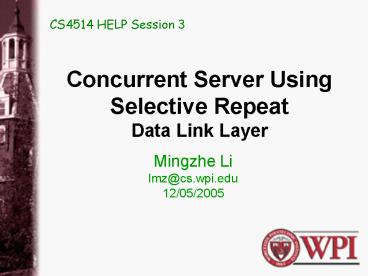Concurrent Server Using Selective Repeat Data Link Layer - PowerPoint PPT Presentation
Title:
Concurrent Server Using Selective Repeat Data Link Layer
Description:
CS4514 HELP Session 3 Concurrent Server Using Selective Repeat Data Link Layer Mingzhe Li lmz_at_cs.wpi.edu 12/05/2005 Description Objective: To implement a simple ... – PowerPoint PPT presentation
Number of Views:30
Avg rating:3.0/5.0
Title: Concurrent Server Using Selective Repeat Data Link Layer
1
Concurrent Server Using Selective Repeat Data
Link Layer
CS4514 HELP Session 3
- Mingzhe Li
- lmz_at_cs.wpi.edu
- 12/05/2005
2
Description
- Objective
- To implement a simple concurrent server and
clients having four emulated network protocol
stacks. - Application layer Customized Applications
- Network layer Message??Packet (sendrecv)
- Datalink layer Packet ?? Frame and Selective
Repeat sliding window protocol - Physical layer TCP connection.
- To get full credit, you need a sending and
receiving windows size gt4. - Your programs should compile and work on any host
of ccc.WPI.EDU.
3
System Overview
(1)
(3)
(2) fork()
(4) fork()
Child Process1
Child Process2
You can either use multiprocesses (fork()) or
multithreading (pthread) You need to implement
concurrent access to the database.
4
System Framework
Client
Server
TCP Connection
Four Layer stacks
5
Selective Repeat
time
fr 0
fr 1
fr 2
fr 3
fr 4
fr 5
fr 2
fr 8
fr 7
fr 6
fr 9
fr 10
fr 11
fr 12
A
A
B
B
ACK2
NAK2
ACK1
ACK7
ACK8
ACK9
ACK10
ACK11
ACK12
ACK2
ACK2
ACK2
error
6
How the System Works Layer by LayerApplication
Layer
Messages
Clienti
Server
Child Process i
Messages
Client Requests Application depended
Server Responses Application depended
nwl_send ( msg ) nwl_recv ( msg )
At least 5 operations, there is at least one long
operation in each direction that will easily
test your sliding window
7
How the System Works Layer by LayerNetwork Layer
Clienti
Server
Message
Message
n_packets
n_packets
Tasks for NWL Disassemble and assemble packets
from Msg. No ACK in this layer Two Bytes
sequence no. for packets
End of Message Can be an special packet, OR a
special position in each packet, eg. 1st byte
dll_send ( pkt ) dll_recv ( pkt )
Note The max_size of a packet is 256 bytes, The
network layer will send packets until blocked by
the Data Link Layer. But HOW?
8
How the System Works Layer by LayerDataLink
Layer
Server
Clienti
ACK or NAK? Piggyback?
packet
packet
Selective Repeat
n_frames
n_frames
- 1 Byte End of Packet
- 2 Bytes Error Detection
- 2 Bytes SEQ
phl_send ( frm ) phl_recv ( frm )
Note The max_size of a frame payload is 100
bytes Sliding window size gt4
9
How the System Works Layer by Layer
Clienti
Server
frame
frame
- Identify client
- when start
- Force Single Bit
- Errors
- - Data 8th frame
- - Ack 6th frame
- - Server and clients
read ( data ) write ( data )
TCP Connection
10
How the Functions Work Layer by Layer
client APP
server child process APP
User input
fork()
Pick a command
nwl_recv()
q cmd?
q cmd?
Yes
No
Yes
No
Build Msg
Build Msg
nwl_send(msg)
nwl_send(msg)
nwl_recv(ack)
11
How the Functions Work Layer by Layer
nwl_send ( msg )
nwl_recv ( msg )
Note you need have a mechanism to decide the
last packet in a message (EOM).
12
How the Functions Work Layer by Layer
dll_send ( pkt )
Split a packet into payloads
Sliding window size 1
Create a new frame
Start a Timer
Send a frame to PHL
phl_send ()
phl_recv ()
Wait for receiving a ACK frame
Retransmit frames if timeout or error ACK frame!
Receive a ACK frame correctly, then continue ...
13
How the Functions Work Layer by Layer
dll_recv ( pkt )
Receive a frame from PHL
phl_recv ()
Compute ED byte and check error
Drop if error detected
phl_send ()
Drop if duplicate, else send ACK
Reassemble the packet
If EOP, forward the packet to NWL
Question When is the correct time to send NAK or
ACK?
Not after ED drop, but on receiving next frame or
dup frame.
14
Project Tips-1
- Sliding Window Protocol Selective repeat (Ngt4)
- Try to implement windows size 1 first
- Then implement N (multiple timers)
- Follow the example in the book (protocol 6)
- How to terminate client process
- When the client gets the response to the quit
message - A clean way to terminate the server child
process? Use wait()!
15
Project Tips-2
- Simulate multiple timer in software
- Approach I
- Using link list or array
- pp.223 on textbook()
- Need signal()
- Approach II
- Using link list or array
- Update the struct timeval for next select() call
16
Project Tip3
- How could the NWL Keep sending packets until
blocked by the Data Link Layer ? - Our suggestion is that you could use pipe to
implement it NWL keeps writing packets to the
pipe until the pipe is full. - A simple code of pipe could be found at
- http//web.umr.edu/ercal/284/PipeExamples/Exampl
es.html - Pipe is more like a socket between local
processes.
17
Concurrent TCP Server Example (fork)
pid_t pid int listenfd, connfd / 1. create a
socket socket() / if ((listenfd
socket(AF_INET, SOCK_STREAM, 0)) lt 0 )
err_quit("build server
socket error\n", -1) / 2. fill in sockaddr_in
with server's well-known port / / 3. bind
socket to a sockaddr_in structure bind() / bind
(listenfd, ...) / 4. specify the backlog of
incoming connection requests listen() / listen
(listenfd, LISTENQ) while(1) connfd
accept(listenfd, ... ) / probably blocks /
if(( pid fork()) 0)
close(listenfd) / child closes listening
socket / doit(connfd) / process
the request / close(connfd) / done
with this client / exit(0)
close(connfd) / parent closes connected
socket /
18
Questions?































